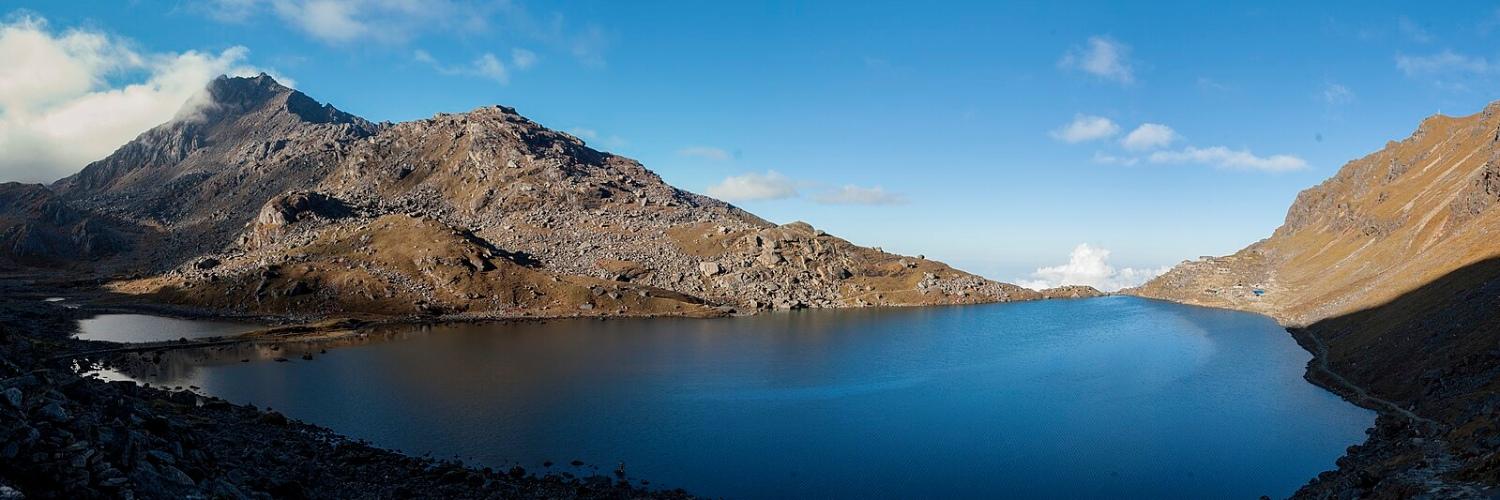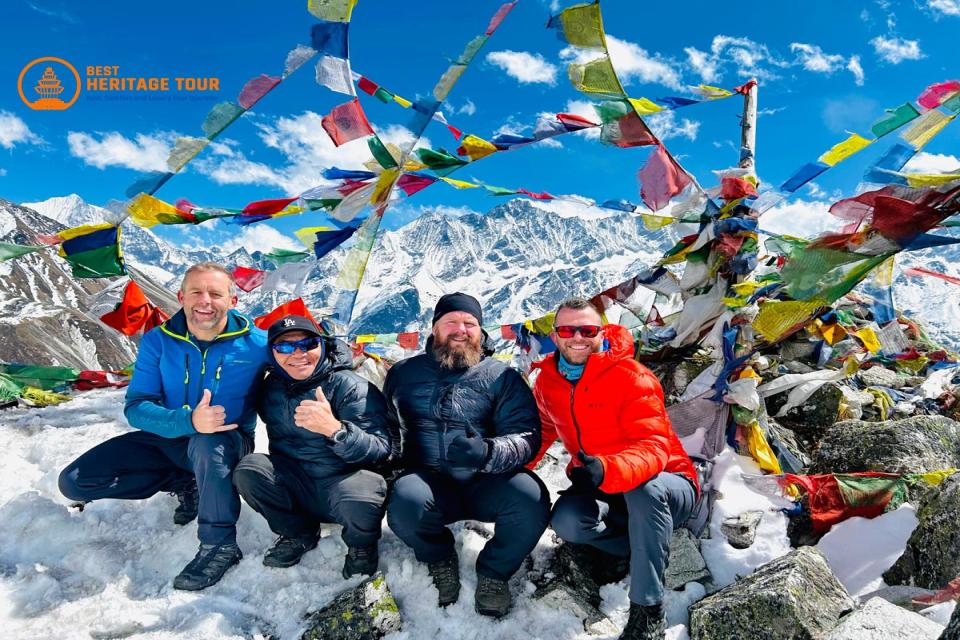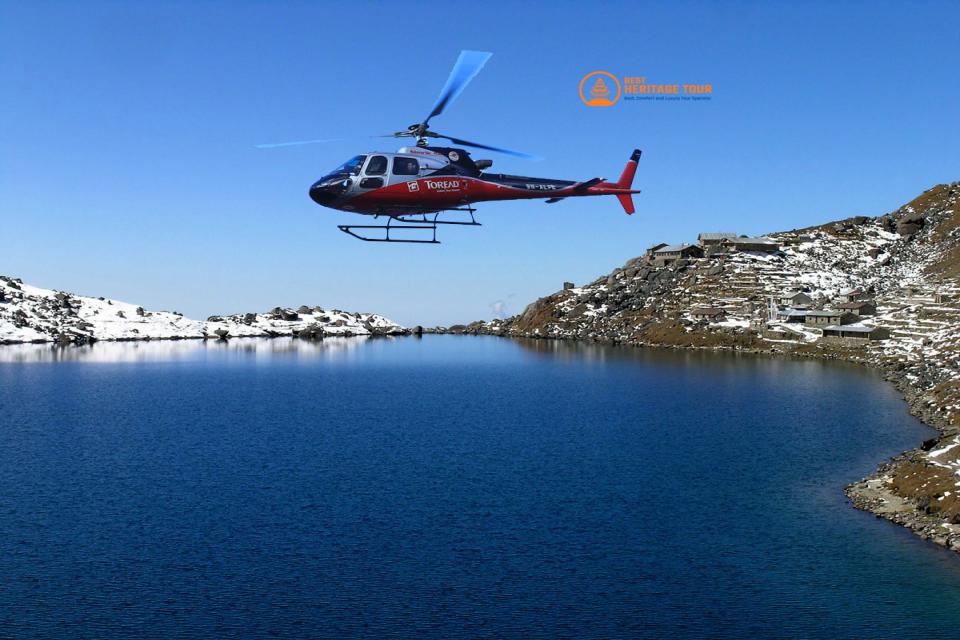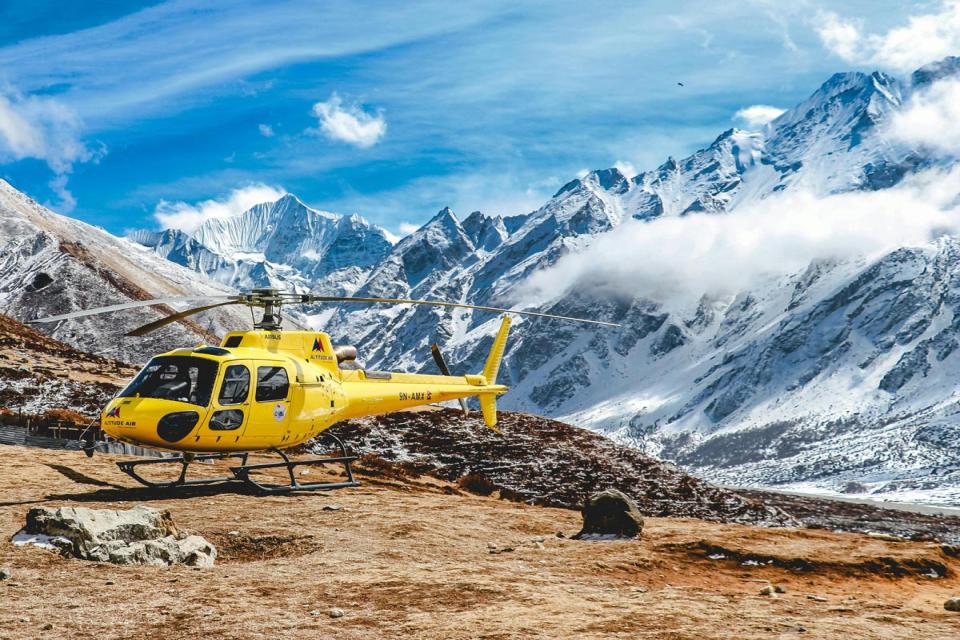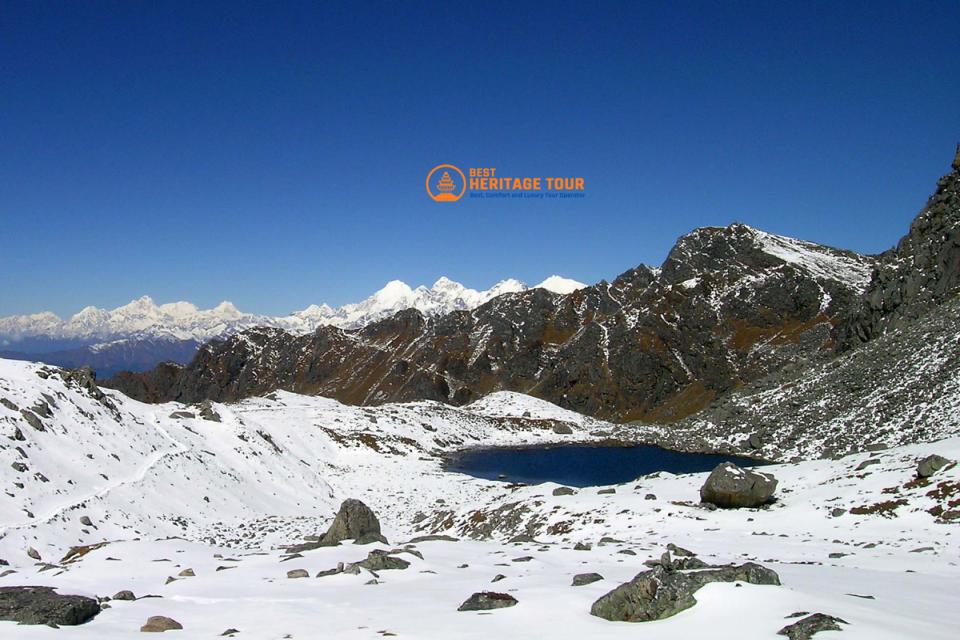Nestled high in the Langtang National Park of Nepal, Gosaikunda Lake is a breathtaking alpine freshwater lake revered for both its spiritual importance and pristine natural beauty. Located at an altitude of around 4,380 meters (14,370 feet), this glacial lake is a prime destination for trekkers, nature lovers, and Hindu-Buddhist pilgrims alike. It’s not just a scenic wonder; it’s a place where mythology, faith, and the high Himalayas meet in perfect harmony.
Every year, thousands of pilgrims undertake the journey to Gosaikunda, especially during the full moon festival of Janai Purnima, believing the sacred waters were created by Lord Shiva himself. At the same time, adventure seekers flock here for the spectacular Gosaikunda Lake trek, a high-altitude trail that blends serene mountain vistas, ancient villages, spiritual stupas, and challenging passes.
Its proximity to Kathmandu yet striking remoteness make it one of the most accessible yet off-the-beaten-path treks in Nepal. Whether you're interested in soaking up Himalayan culture, exploring wild landscapes, or diving into ancient legends, Gosaikunda has something timeless to offer.
In this complete guide, we’ll walk you through everything you need to know about Gosaikunda Lake, from how to get there and what makes it spiritually significant to trekking tips, natural highlights, and when to visit.
Location and Geography of Gosaikunda Lake
- Where is Gosaikunda Lake Located?
Gosaikunda Lake lies in the Rasuwa District of central Nepal, within the protected bounds of Langtang National Park. It’s situated north of Kathmandu and east of the Langtang Valley, close to the border with Tibet (China). The lake is part of a larger collection of glacial lakes in the region, but Gosaikunda stands out as the most revered.
- Altitude and Physical Characteristics
Perched at an elevation of 4,380 meters, Gosaikunda is a high-altitude freshwater lake formed by glacial melt and snow runoff from the surrounding peaks. It spans roughly 13.8 hectares and freezes completely in the winter months. The panoramic surroundings include views of Langtang Lirung, Ganesh Himal, and Manaslu on a clear day.
- Formation and Natural Features
The lake was carved out by glacial activity thousands of years ago. It’s surrounded by rocky hills and moraine ridges, with minimal vegetation at this altitude. Gosaikunda is one of over a dozen lakes in the vicinity, including Saraswati Kunda, Bhairav Kunda, and Surya Kunda, each with its own spiritual lore.
- Which River Starts from Gosaikunda?
One of the most important hydrological features of Gosaikunda is that it is the source of the Trishuli River, one of Nepal’s major rivers. The water from Gosaikunda Lake flows down through underground channels before emerging as the Trishuli, which then winds its way through central Nepal, supporting agriculture, hydropower, and rafting tourism. This adds to Gosaikunda's spiritual and ecological significance; the lake is not only sacred but also hydrologically vital.
- Surrounding Flora and Fauna
Lower parts of the trail toward Gosaikunda are rich in biodiversity. You’ll pass through dense forests of rhododendron, pine, oak, and bamboo. Wildlife sightings may include red pandas, Himalayan black bears, musk deer, langurs, and a variety of birds like Himalayan monals, eagles, and pheasants.
Spiritual and Cultural Significance
Gosaikunda is more than just a glacial lake; it is one of Nepal’s most sacred pilgrimage sites, deeply rooted in Hindu mythology and revered by Buddhists as well. Its sacred reputation draws thousands of pilgrims annually, especially during religious festivals, creating a spiritual aura that complements the natural grandeur of the Langtang region.
- Religious Importance in Hinduism and Buddhism
In Hinduism, Gosaikunda is believed to be the abode of Lord Shiva and Goddess Gauri. According to sacred texts like the Skanda Purana, when Shiva drank the poison to save the world (during the churning of the ocean, or Samudra Manthan), he thrust his trident into the Himalayas to create Gosaikunda so he could cool his burning throat. The lake is thus considered to contain holy water imbued with Shiva’s divine essence.
For Buddhists, especially among the local Tamang and Sherpa communities, Gosaikunda is linked to Guru Rinpoche (Padmasambhava) and other Himalayan deities. The lake is often circled in prayer (kora) by Buddhist pilgrims, who consider its still waters a source of inner purification and enlightenment.
-
The Legend and Mythology Behind Gosaikunda
Local lore adds color to Gosaikunda’s spiritual significance. According to one popular legend, Shiva created the lake with his trident (Trishul), and his divine energy still resides in the waters. Another tale speaks of a hidden spring within the lake that never dries, symbolizing eternal life.
The surrounding lakes, Bhairav Kunda, Saraswati Kunda, Surya Kunda are believed to be extensions of Gosaikunda, each with their own spiritual stories. Bathing in these waters is said to wash away sins and bring blessings from the gods.
-
Annual Festivals and Pilgrimages (Janai Purnima)
Janai Purnima, held every August during the full moon of Shrawan, is the biggest annual event at Gosaikunda. Thousands of Hindu pilgrims from Nepal and India, including Brahmins and Shamans, trek here to change their sacred thread (janai) and bathe in the holy lake.
The lake fills with vibrant spiritual rituals, chants, and prayers from dawn to dusk. Buddhist monks and lamas also gather to meditate and offer butter lamps, creating a peaceful yet powerful atmosphere.
- Local Sherpa and Tamang Traditions
The indigenous Tamang and Sherpa communities living in the lower villages maintain a strong connection with Gosaikunda. They celebrate local festivals, offer prayers, and respect the mountain as a sacred entity. Many also serve as guides and hosts to visiting pilgrims and trekkers.
Gosaikunda Lake Trek
The Gosaikunda Lake trek is one of Nepal’s most rewarding short-to-moderate treks, offering a mix of sacred lakes, dramatic Himalayan views, ethnic villages, and serene trails. It’s the perfect choice for those looking to experience Trekking in Nepal without committing to the longer and more commercialized circuits like Annapurna or Everest.
Overview of the Gosaikunda Lake Trek
The Gosaikunda Lake Trek is one of Nepal’s most spiritually enriching and scenically rewarding treks. It can be undertaken as a standalone journey or combined with the Langtang Valley trek or Helambu Circuit. It’s relatively short but steep, offering a great challenge for trekkers looking for high-altitude adventure without the crowds of Everest or Annapurna.
Trekking Routes and Itinerary Options
Common itineraries include:
-
Kathmandu – Dhunche – Chandanbari – Lauribina – Gosaikunda – Sing Gompa – Dhunche – Kathmandu (7–9 days)
-
Or longer combos like Langtang Valley – Gosaikunda – Helambu (14–16 days)
Duration and Distance of the Trek
Most Gosaikunda treks are around 70–80 kilometers round trip, taking 7 to 10 days depending on your pace and itinerary.
Trekking Highlights Along the Way
-
Chandanbari (Sing Gompa): Home to a famous monastery and yak cheese factory
-
Laurebina Yak: Offers stunning sunrise and sunset views
-
Gosaikunda Lake: The spiritual and scenic climax of the trek
-
Laurebina Pass (4,610 m): A high-altitude challenge with epic views
-
Langtang National Park: Rich in biodiversity and protected Himalayan ecosystems
-
Local Culture: Engage with Tamang and Sherpa villagers, sample traditional foods, and learn local customs
Whether you're a first-time trekker or a seasoned Himalayan explorer, the Gosaikunda Lake trek is an unforgettable journey into the sacred heart of Nepal’s mountains.
Is Gosaikunda Trek Difficult?
A common question among first-time and even experienced hikers is: “Is the Gosaikunda trek difficult?” The short answer is moderately challenging, depending on your physical condition, trekking pace, and acclimatization. Though it’s not the hardest trek in Nepal, it does demand respect due to high altitudes and steep ascents.
Difficulty Level Explained (Altitude, Terrain, Weather)
-
Altitude: The highest point at Laurebina Pass (4,610m/15,125ft) requires proper acclimatization to avoid altitude sickness; Gosaikunda Lake sits at 4,380m.
-
Terrain: Mix of clear trails, rocky climbs, and narrow ridges; steep sections between Chandanbari, Laurebina Pass, and Gosaikunda. No technical climbs.
-
Weather: Unpredictable high-altitude weather with winter snow, spring ice, and slippery monsoon trails; cold nights near the lake add to the challenge.
Physical Demands and Fitness Requirements
Trekkers should have:
- Good cardiovascular fitness
- Experience walking 5–7 hours a day on uneven trails
- No serious respiratory or heart conditions due to the high elevation
That said, the Gosaikunda trek is suitable for beginners with reasonable fitness, especially if you take your time and allow for altitude adjustment.
Tips for Beginners vs Experienced Trekkers
For Beginners:
- Choose the longer itinerary to acclimatize gradually
- Stay well-hydrated and avoid alcohol
- Don’t skip rest stops like Chandanbari or Laurebina Yak
- Hire a local guide or porter for support and navigation
- Take a day hike around Gosaikunda for acclimatization before crossing Laurebina Pass
For Experienced Trekkers:
- You can complete the trek in 5–6 days, but still monitor altitude symptoms
- Consider combining Gosaikunda with the Langtang Valley trek or Helambu circuit for a longer adventure
- Tackle Laurebina Pass confidently, but be cautious in early spring or winter
Common Challenges and How to Overcome Them
|
Challenge |
Solution |
|---|---|
|
Altitude Sickness |
Acclimatize slowly, take Diamox if needed, descend if serious |
|
Steep Ascents |
Use trekking poles, pace yourself, take breaks |
|
Cold Temperatures |
Layer clothing, bring a -10°C sleeping bag |
|
Lack of Oxygen at Altitude |
Breathe deeply, walk slowly, stay calm |
|
Remote Trails |
Carry power bank, water purification, and backup medicine |
Verdict: So, is Gosaikunda trek difficult? Not overly, but it’s not easy either. With proper preparation, pacing, and a bit of mountain grit, most people with moderate fitness can complete it and come away with a life-changing experience.
How to Go Gosaikunda from Kathmandu
One of the advantages of the Gosaikunda Lake trek is its proximity to Nepal’s capital city. If you're wondering how to go to Gosaikunda from Kathmandu, the journey starts with a road trip and then continues on foot. While it may not be the easiest trip logistically, it’s one of the most rewarding.
Transportation Options to Trailhead
To begin the trek, you need to get to either Dhunche or Syabrubesi, which are popular starting points located in Rasuwa District. Here are the main options:
- Local Bus (Budget Option)
- Departure Point: Machhapokhari (New Bus Park), Kathmandu
- Destination: Dhunche or Syabrubesi
- Duration: 6–8 hours
- Cost: NPR 700–1,000 (approx. USD 6–8)
These buses are inexpensive but often crowded and slow, stopping frequently for passengers and rest breaks.
- Private Jeep (Comfortable and Faster)
- Best for: Groups or those looking for comfort
- Duration: 5–6 hours
- Cost: NPR 25,000–35,000 round trip per vehicle
- Road Condition: Bumpy, especially after Trishuli Bazaar, but scenic
Jeep rentals can be arranged through trekking agencies or local travel operators. This is the preferred option for those carrying gear or traveling in small groups.
- Helicopter Charter (Luxury Option)
- Departure: Tribhuvan International Airport, Kathmandu
- Landing: Laurebina, Gosaikunda Ridge, or nearby helipads (depending on weather)
- Duration: ~30–40 minutes
- Cost: USD 300–500 per person (shared), or more for private charter
A scenic helicopter ride to Gosaikunda offers aerial views of the Himalayas, but weather and visibility can be limiting factors. This option is perfect for time-restricted travelers or those unable to hike due to physical limitations.
Route from Kathmandu to Dhunche or Syabrubesi
- By Bus: Departs early morning from Machhapokhari (near Balaju). Affordable but bumpy ride
- By Jeep: Faster, more comfortable, ideal for groups
- Travel time: 6–8 hours depending on road conditions
Recommended Travel Plans and Timing: Leave Kathmandu early and stay overnight in Dhunche to acclimatize. Then begin your trek the next morning. Always buffer extra days for weather or health-related delays.
Tips for Acclimatization and Altitude Sickness Prevention
- Don’t rush the ascent; spend a night in Chandanbari or Laurebina to help adjust
- Stay hydrated, and avoid alcohol and caffeine
- Take short acclimatization hikes during the day
- Watch for symptoms like headache, nausea, or dizziness, especially after 3,000 meters
- Carry Diamox (acetazolamide) after consulting your doctor
Best Time to Visit Gosaikunda Lake
Timing is everything when planning your trek to this sacred Himalayan gem. While Gosaikunda Lake is accessible most of the year, some seasons offer ideal weather, clearer views, and safer trekking conditions. Knowing the best time to visit Gosaikunda Lake will help you plan a more enjoyable and meaningful trip.
Seasonal Weather Patterns
-
Spring (March to May): Best visibility, blooming rhododendrons
-
Autumn (September to November): Clear skies, perfect trekking conditions
-
Winter (December to February): Snow-covered, extremely cold, lake often frozen
-
Monsoon (June to August): Wet, slippery trails but good for pilgrimage (Janai Purnima)
Pros and Cons of Trekking in Different Seasons
|
Season |
Pros |
Cons |
|---|---|---|
|
Spring |
Flowers, pleasant weather |
Can be crowded |
|
Autumn |
Clear views, dry trails |
Cold nights |
|
Winter |
Unique snowy landscapes |
Harsh conditions |
|
Monsoon |
Cultural richness |
Risk of landslides and leeches |
Special Events and Festivals Timing
- Janai Purnima (Full moon of August): Spiritual energy, huge pilgrim gatherings
- Buddha Jayanti (May): Observed by Buddhist communities en route
Nature and Wildlife around Gosaikunda
The region surrounding Gosaikunda Lake is not only sacred but also a thriving natural sanctuary nestled within Langtang National Park, Nepal’s first Himalayan protected area established in 1976. This makes the trek and pilgrimage a unique opportunity to experience pristine Himalayan biodiversity alongside cultural heritage.
Overview of Rasuwa District’s Biodiversity: Rasuwa District, where Gosaikunda is located, is home to a diverse range of ecosystems, from dense subtropical forests at lower elevations to alpine meadows and glacial landscapes at higher altitudes. The altitudinal variation creates habitats for numerous species, many endemic or endangered.
The Langtang National Park protects:
- Over 300 species of birds
- Around 75 species of mammals
- Unique alpine plants and medicinal herbs
This rich biodiversity supports the ecological balance crucial for local communities and the health of the entire Himalayan environment.
Common Animals and Birds Spotted on the Trek: While trekking to Gosaikunda, hikers may encounter:
-
Red Panda: A shy and endangered species native to the eastern Himalayas. Sightings are rare but highly prized.
-
Himalayan Tahr: A large wild goat adapted to rocky alpine terrain, often seen grazing on steep slopes.
-
Langurs: Agile monkeys common in mid-hill forests.
-
Musk Deer: Not easily spotted but known to inhabit dense forests nearby.
-
Birdlife: The area is a birdwatcher’s delight with species like the Himalayan Monal (Nepal’s national bird), Blood Pheasant, Spotted Nutcracker, and various raptors including eagles and vultures.
Trekking early mornings or late afternoons increases chances of wildlife sightings.
Conservation Efforts and Eco-Tourism: Langtang National Park authorities actively promote conservation efforts to protect fragile ecosystems and endangered species. Trekkers and pilgrims are encouraged to practice eco-friendly trekking by:
- Carrying out all waste and avoiding plastic use
- Respecting wildlife and not disturbing natural habitats
- Supporting local conservation programs through permits and donations
- Using local guides who understand sustainable trekking practices
- In recent years, eco-tourism initiatives have also empowered the indigenous Tamang and Sherpa communities, balancing environmental preservation with cultural integrity.
Practical Tips for Trekking Gosaikunda
Embarking on the Gosaikunda Lake trek requires preparation to ensure safety, comfort, and respect for local culture. Whether you’re a seasoned trekker or a first-timer, these practical tips will help you make the most of your Himalayan adventure. Here's the Essential Packing Checklist for Gosaikunda Trek:
-
Clothing:
- Layered clothing system (base, insulating, and waterproof layers)
- Warm jacket (down or synthetic) for cold nights
- Trekking pants and moisture-wicking shirts
- Gloves, hat, and buff for sun and cold protection
- Good quality trekking boots with ankle support
- Extra socks (wool or synthetic)
-
Gear:
- Backpack (30–40 liters) with rain cover
- Sleeping bag rated for -10°C or lower
- Trekking poles for stability on steep or slippery terrain
- Headlamp with extra batteries
- Water purification tablets or filter
-
Health & Safety:
- Personal medications and first aid kit
- Sunscreen and lip balm with high SPF
- Insect repellent (especially for lower forested areas)
- Altitude sickness medication (consult your doctor before trek)
-
Other Essentials:
- Trekking permit (Langtang National Park permit and Annapurna Conservation Area permit if applicable)
- Trekking map or GPS device
- Cash in small denominations (ATMs are scarce)
- Power bank for electronics
Health and Safety Tips
-
Acclimatize properly: Ascend slowly and rest at key points like Chandanbari and Laurebina Yak.
-
Stay hydrated: Drink plenty of water to combat altitude effects.
-
Eat well: Maintain energy levels with balanced meals and snacks.
-
Avoid alcohol and smoking: Both can worsen altitude sickness symptoms.
-
Listen to your body: Headache, nausea, dizziness, or fatigue may signal altitude sickness, descend immediately if symptoms worsen.
Cultural Etiquette to Observe
- Always ask permission before taking photos of locals, especially during festivals and religious ceremonies.
- Respect religious sites: remove shoes before entering temples or monasteries.
- Do not touch or disturb prayer flags, stupas, or offerings.
- Dress modestly, particularly in villages and sacred areas.
- Be friendly and patient, local hospitality is warm but may involve language barriers.
Local Guides and Porter Hiring Advice
Hiring a local guide or porter is highly recommended, especially for first-timers or those unfamiliar with high-altitude trekking. Benefits include:
- Navigational support and local knowledge
- Cultural interpretation and communication with villagers
- Assistance with carrying heavy loads, allowing you to enjoy the trek more
- Support in case of emergencies
When hiring, ensure fair wages, proper equipment, and ethical treatment. Many trekking agencies in Kathmandu and Dhunche offer reputable services.
Gosaikunda Lake in Popular Culture and Media
Gosaikunda Lake’s spiritual allure and stunning natural beauty have inspired numerous stories, documentaries, and media projects, cementing its status as one of Nepal’s iconic Himalayan landmarks.
-
Films, Documentaries, and Books Featuring Gosaikunda: Gosaikunda has been featured in travel documentaries, spiritual journey films, and Nepali literature exploring Himalayan mysticism. Photographers and bloggers often document the dramatic reflections and high-altitude serenity of the lake.
-
Testimonials from Trekkers and Pilgrims: Many trekkers describe the lake as "a place of stillness that touches the soul." Pilgrims speak of a sense of purity and fulfillment after bathing in the icy waters. The sense of spiritual energy and stark beauty leaves a lasting impression.
Conclusion: Discover the Magic of Gosaikunda Lake
Gosaikunda Lake is one of Nepal’s most stunning natural and spiritual treasures, perched at 4,380 meters with sacred significance in Hindu and Buddhist traditions. This trek offers breathtaking alpine views, rich culture, and unforgettable high-altitude adventure.
Whether crossing Laurebina Pass, joining the vibrant Janai Purnima festival, or exploring Tamang and Sherpa villages, Gosaikunda connects you deeply to Nepal’s Himalayan heart. Accessible via scenic routes from Kathmandu, this moderate trek challenges and rewards every traveler.
Beyond its beauty, Gosaikunda is an ecological hotspot feeding the Trishuli River and supporting diverse wildlife. Your visit promotes sustainable tourism and helps preserve this sacred landscape.
Ready to plan your Gosaikunda Lake Trek in 2025/2026? Contact Best Heritage Tour for expert-led trips, easy permits, and customized itineraries designed to make your journey seamless and unforgettable.
Book now or get more info now:
- Phone/WhatsApp/Viber: +9779851149197 / +9779810043046
- Email: bestheritagetour@gmail.com / info@bestheritagetour.com
- Website: www.bestheritagetour.com
- Location: Thamel Marg, Kathmandu, Nepal
Plan your Himalayan adventure to include Gosaikunda Lake, a perfect blend of nature, spirituality, and culture in Nepal’s majestic mountains.
Author: Best Heritage Tour
Date: 25th June, 2025

